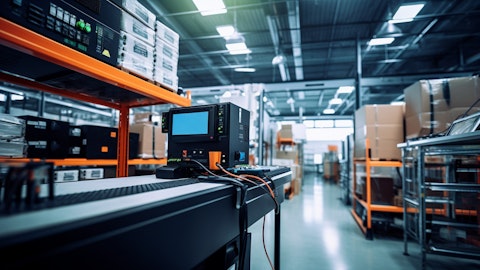Establishment Labs Holdings Inc. (NASDAQ:ESTA) Q1 2025 Earnings Call Transcript May 10, 2025
Operator: Good afternoon, and welcome to the Establishment Labs First Quarter 2025 Earnings Conference Call. At this time, all participants are in a listen-only mode. At the end of the call, we will open the line for question-and-answer session. [Operator Instructions]. As a reminder, today’s call is being recorded. I’ll now turn the call over to Raj Denhoy, Chief Financial Officer. Thank you. You may begin.
Rajbir Denhoy: Thank you, operator and thank you everyone, for joining us. With me today is Peter Caldini, our Chief Executive Officer; and Juan Jose Chacon-Quiros, our Founder, Former CEO and a member of our Board of Directors. Following our prepared remarks, we’ll take your questions. Before we begin, I would like to remind you that comments made by management during this call will include forward-looking statements within the meanings of federal securities laws. These include statements on Establishment Labs’ financial outlook and the company’s plans and timing for product development and sales. These forward-looking statements are based on management’s current expectations and involve risks and uncertainties. For a discussion of the principal risk factors and uncertainties that may affect our performance or cause actual results to differ materially from these statements, I encourage you to review our most recent annual and quarterly reports on Form 10-K and Form 10-Q as well as other SEC filings, which are available on our website at establishmentlabs.com.
I’d also like to remind you that our comments may include certain non-GAAP financial measures with respect to our performance, including, but not limited to sales results, which can be stated on a constant currency basis or profitability of the company’s business, which can be stated as EBITDA or adjusted EBITDA. Reconciliations to comparable GAAP financial measures for non-GAAP measures, if available, may be found in today’s press release, which is available on our website. The content of this conference call contains time-sensitive information accurate only as of the date of this live broadcast, May 7, 2025. Except as required by law, Establishment Labs undertakes no obligation to revise or otherwise update any statement to reflect events or circumstances after the date of this call.
With that, it is my pleasure to turn the call over to our Founder, Juan Jose.
Juan Jose Chacon-Quiros: Thank you, Raj. Along with our first quarter earnings, we also announced today the appointment of Peter Caldini as permanent CEO of Establishment Labs. Since my retirement was announced in January, the Board of Directors has undergone an extensive review of potential candidates. And following that process, the Board was unanimous in their endorsement of Peter to take the role of CEO. Peter is the right CEO at the right time for our company. As the Founder and CEO for the past 20 years, I’ve seen our company evolve from an idea that could revolutionize breast aesthetics and reconstruction by prioritizing science and data to where we are today. We’ve grown that idea to a suite of products and technologies with unmatched clinical performance.
Our products are available globally. And we’ve moved the industry into a new era by making the implants better and safer and by bringing new technologies and techniques like minimally invasive to market. The next phase of growth needs a steady hand to help us achieve the financial potential of what we have put into motion. With healthy growth for many years to come, our task now is to reach profitability. Peter’s experience running large multinational organizations over the past 25 years as well as the seamless way he has become an important member of our management team made the choice for the Board quite easy. As I have said before, I am not going anywhere. I’m going to continue to work tirelessly for Establishment Labs in the role that has always been my first love, working with plastic surgeons to elevate the specialty, strategizing the launch of new products and techniques, supporting our R&D to make even greater strides in advocating for a company to be a leader for women’s health.
I’m proud of the team at Establishment Labs, and I am excited for Peter to lead our organization in this next chapter of our story. With both Peter and Raj as well as other members of our management team, I look forward to seeing you on June 12 at our Investor Day in New York City. Peter, I will turn it over to you.
Peter Caldini: Thank you, JJ. I am honored to be taking over as CEO and grateful for your continued support. I look forward to working with you as we continue on the journey that you started two decades ago. I am also pleased to report a strong start to 2025. Revenue in the first quarter totaled $41.4 million. Our first quarter sales included $6.2 million from the United States. This was above the $5.5 million we previously guided in late February and reflects the strong adoption that has continued into the second quarter. Outside the United States, first quarter sales met our expectations with the markets generally stable to improving. We are reiterating guidance of $205 million to $210 million, and this does take into consideration the past several months of tariff-related impacts.
To date, we have not seen any impact on our sales and our conversations with plastic surgeons around the world suggest they are continuing to have consultations and book procedures at a similar pace. Our guidance is designed to be conservative, and we continue to expect our OUS revenue to have single-digit growth this year. Our U.S. revenue should meaningfully exceed the $35 million we guided in February. And as such, we are highly confident in our outlook. In the first quarter, we made good progress in leveraging our operating expenses and improving cash flow and continue to forecast our first positive EBITDA quarter in 2025 as well as cash flow breakeven in 2026. Raj will provide additional details on our results and outlook in a moment. The launch of Motiva in the U.S. continues to exceed our expectations.
As of May 1, we had over 900 accounts fully on board and over 700 have already placed orders with 84% reordering. Our daily orders for the month of April exceeded 120, up from 100 in March. A couple of things to note here. While we felt it was important to provide metrics to allow investors to track our early progress, we are moving towards a more normal cadence, so you should expect updates in line with our quarterly calls. Also, I would remind you that you cannot calculate monthly or quarterly revenue from our daily order number. We generally account for revenue when a doctor uses the device, not when it’s ordered. We provide this information so you can directionally appreciate how well our launch is going and appreciate that we are on track for one of the best launches in aesthetics history.
As a company, we are focused on becoming the market share leader in the U.S. We are off to a very good start. And with our pipeline of innovations making its way through the regulatory process, we expect to be an unparalleled leader for a very long time. Our engagement with plastic surgeons continues to be very high. We hosted over 100 U.S. surgeons in Costa Rica in 2024, and we’ll have over 120 attending training events in 2025. We have groups coming down almost every month. We also have regular master classes in the United States that have had very high interest and attendance. Surgeon excitement is mirrored by women who are interested or have had augmentation with Motiva. We constantly hear from surgeons that women are entering their clinics specifically asking for Motiva Implants by name, which is fairly unprecedented in the industry.
Perhaps most interesting, numerous plastic surgeons have reported that women coming in for breast revision surgeries covered under competitor warranties have specifically asked to pay for Motiva Implants rather than use free implants covered under their warranty. The testimonials from women that have had other implants and now have Motiva are compelling. We continue to see new organic content posted online, including from celebrities and other influencers. In March, we announced our first sponsored partnership with Meghan Trainor. She mentioned in November on her podcast that she was ready for a breast augmentation after breast feeding her children and losing weight. When we were put in touch with her, Meghan, in consultation with their plastic surgeon had already chosen Motiva Implants.

She has been an excellent spokesperson for our brand and her experience has resonated with countless women. In just a few weeks, there have been over 75 press articles on Meghan’s journey with Motiva. The partnership has generated over 4 billion impressions. The ROI on this initiative is very clear, and we are certainly considering more opportunities. It has been notable to see how much this partnership has resonated with the plastic surgeon community. This is the first A-List celebrity sponsorship in the category and many surgeons have been enthused that a company is finally focused on increasing awareness after years where the incumbents have done no real innovation and no real marketing specific to breast aesthetics. Plastic surgeons have felt left behind for years as the aesthetics industry focused on dermatologists and med spas perceived as more lucrative group as the Establishment Labs sole focus on board-certified plastic surgeons is highly appreciated.
In reconstruction, our tissue expander is continuing to gain traction, and we have completed the VAC process at more than 60 of the premier cancer centers in the U.S. and we have initiated processes at over 100 additional hospitals. With our recent launch of Preserve in Latin America and Europe, our minimally invasive platform continues to build momentum, both in terms of revenue and changing the industry narrative from a patient and doctor perspective. The foundational technology platform behind both Mia Femtech and Preserve allows plastic surgeons to create natural results by preserving the breast anatomy and function. We have termed these approaches breast tissue preservation as they both reduce the amount of tissue damage done during the procedure.
That said, they differ in notable ways in terms of what patients they are designed for. Mia is intended for primary augmentations with a one to two cup size increase with injectable implants. It allows for no visible scars on the breast and offers a faster recovery without the use of general anesthesia at top certified centers. Mia is a premium offering designed to appeal to the women who have not been interested in traditional breast augmentation but are using padded or push-up bras. So by definition, Mia should be market expanding. For 2025, Mia remains on track to achieve $8 million to $10 million in revenue we have forecasted. Preserve builds on the learnings from Mia and is designed for the day-to-day procedures that make up the majority of breast augmentation cases performed by plastic surgeons.
It leverages the minimally invasive tools and techniques pioneered with Mia, but is more flexible for the surgeon and can be used in a wider cross-section of cases and larger sizes. It is designed to be the premium choice for women who are already considering breast augmentation surgery and early experience tells us that it may also be market expanding. With the launch of Preserve, we now have options for surgeons and women that range from our core implant offering of Round, Ergonomix and Ergonomix2 to Preserve and Mia at the premium end of the market. Each step-up provides increased value and benefit to patients and surgeons as well as to us with higher price points and gross margin. We expect that both breast tissue preservation options will dramatically change the surgeon’s approach to breast aesthetics and will have a significant impact on our future growth.
We launched Preserve in Brazil in February and in a select group of countries in Europe in April. Most recently, we launched Preserve in the first group of countries in Latin America at the SAPS Conference in Colombia. The early adoption by plastic surgeons is quite promising and appears that breast tissue preservation will be a meaningful part of our future growth and will even contribute to our numbers this year. We will continue our rollout into additional countries and regions over the coming quarters. I will turn the call over to Raj.
Rajbir Denhoy: Thank you, Peter. Total revenue for the fourth quarter was $41.4 million, an increase of 11% from the year ago period. Excluding the negative impact of foreign exchange in the quarter, growth would have been 13.5%. Sales from Motiva in the United States were $6.2 million. There were several items that should be considered in comparing the results this quarter to a year ago. As we have previously communicated, we generated minimal sales into China in the first quarter. Our distributor purchased approximately $10 million of inventory last year to begin commercial operations and is now selling out that inventory as our procedure share grows. As demand in the market matches supply, we expect to see additional orders.
This is a normal trajectory for a new distributor market, particularly one the size and complexity of China. Brazil has stabilized with revenue in the first quarter up from the fourth quarter, but we still experienced a meaningful reduction from the first quarter of last year. Also of note, we benefited from the purchase of our Benelux distributor in the fourth quarter. When factoring these items, revenue growth outside the U.S. was approximately 5% in the first quarter, in line with our expectations. Our gross profit for the first quarter was $27.8 million or 67.2% of revenue, a 160 basis point increase compared to 65.6% of revenue for the same period in 2024. We expect our gross margin will continue to improve over the course of the year as sales in the United States become a larger part of our business.
We expect gross profit margins in 2025 will be approximately 200 basis points to 300 basis points higher on an underlying basis compared to 2024. As it relates to tariffs, the proposed duties on goods imported from Costa Rica to the United States would represent less than a 50 basis point gross margin impact on a consolidated basis and do not change our trajectory for margin improvements this year. SG&A expenses of $39.7 million were approximately $10.8 million higher than in the first quarter of 2024. R&D expenses for the first quarter were $5.1 million. Total operating expenses for the first quarter increased approximately $11.5 million from the year ago period to $44.8 million. The increase in operating expenses was due primarily to the ramp-up of commercial activity in the United States following approval of Motiva Implants in late September as well as the operating expenses in the Benelux subsidiary we acquired in the fourth quarter.
We continue to expect operating expenses will be approximately $45 million to $46 million per quarter this year. Adjusted EBITDA was a loss of $12.1 million. Our loss was approximately $1 million lower than the $13.1 million in the fourth quarter. This was despite sequentially lower revenue in the first quarter. We expect to see further improvements into the second quarter and to reach our first EBITDA positive quarter in the second half of this year. Our cash position on March 31 was $69.2 million. We have an additional $25 million still available under our credit facility, putting our total accessible cash balance at approximately $94 million. Our cash use in the first quarter was $21.2 million. As we noted previously, the fourth quarter of last year and the first quarter of this year should be the highest for us in terms of cash use as we launch in the U.S. Our cash flows will improve meaningfully as we leverage these investments against higher sales expected in the United States over the coming quarters.
We expect to see sequential improvement in our cash loss each quarter over the balance of the year, and we should reach cash flow breakeven in 2026. Cash use should come down by approximately $5 million a quarter each quarter over the course of 2025 as we approach profitability. Under our current outlook, we expect to get to cash flow positive in 2026 without the need for any additional equity raises. Our revenue guidance for 2025 remains $205 million to $210 million, representing growth of 23% to 26%. We expect to see good sequential growth both in the United States and OUS in the second quarter. We are very mindful of the current dynamics in the global economy and the uncertainty recent trade policies are creating. Our thinking on guidance includes the impact of tariffs as currently proposed.
Importantly, to date, we have not seen any impact on demand. As we have shown in past periods, we will react to any slowdown that might develop and we’ll reduce our expense base as needed. We are committed to achieving our revenue, profitability and cash flow targets and are confident in the outlook we have provided. I’ll turn the call back over to Peter.
Peter Caldini: Thank you, Raj. I am excited to be taking over the leadership of Establishment Labs at such a seminal point in our company’s history. We have now launched our products into the largest and highest value markets in the world. We have brought forward a number of significant advances from our minimally invasive platform. Both Mia and Preserve continue to make good on the promise of expanding our markets as women are drawn to more natural and safer breast procedures. With this as a foundation, we are now tasked with driving efficiency in our organization. As we progress through the year, we are focused on four main priorities: driving growth in the U.S., increasing efficiency and profitability across the organization, the ongoing launch of our minimally invasive portfolio and advancing our innovation pipeline.
We continue to make significant progress on all fronts. We will provide updates on our progress across our major initiatives at our upcoming Investor and Analyst Meeting, which is being held on the afternoon of June 12 in New York City. If you would like to attend, please e-mail ir@establishmentlabs.com. Operator, we are ready to take questions.
Q&A Session
Follow Establishment Labs Holdings Inc. (NASDAQ:ESTA)
Follow Establishment Labs Holdings Inc. (NASDAQ:ESTA)
Receive real-time insider trading and news alerts
Operator: Thank you. We will now be conducting a question-and-answer session. [Operator Instructions]. First question here is from Marie Thibault from BTIG. Please go ahead.
Marie Thibault: Hi, good afternoon. Thanks for taking the questions and Peter, congrats on the official appointment here. Glad to be working with you.
Peter Caldini: Thank you.
Marie Thibault: I wanted to use my first question here on the OUS outlook. Definitely appreciate that you’ve given us this commentary that you haven’t seen an impact on demand that bookings are normal. Can you confirm for me the mid-single-digit guidance that I think you’ve talked about in the past and maybe break down consumer sentiment by region, and we’re particularly interested in hearing about Brazil, Southeast Asia and China, if you can.
Peter Caldini: Yes. Thank you. As we highlighted in the beginning of the call is the OUS business, we haven’t seen any impact in terms of demand, and we continue to be very confident that we’ll continue to drive the business in those markets. As it relates to the different regions, it’s very similar to what we’ve said in the past. Asia has stabilized last year. We’re starting to see different areas of growth. Europe also stabilized in different pockets of growth. And I think the one market or one region where we continue to see some challenges is Latin America. And I think for our business in Brazil, I think we’ve really stabilized. We’re starting to see some growth, but the market itself continues to be challenging.
Marie Thibault: Okay. That’s very helpful. Thank you for that. And then I want to dig in a little bit more on Preserve. Congrats on launching that in some countries. You mentioned it could be market expanding. I’d love to hear a little bit more about how that population, how you sort of characterize that implant population and how it’s being positioned versus Motiva? And also any time lines you might give us for both Mia and Preserve in the U.S., if you can?
Peter Caldini: Okay. Yes. So I’ll start off with Preserve. So it’s actually — we’ve gotten very strong response where we rolled it out in Dusseldorf, also in Brazil as well as in Colombia most recently. What we’re seeing is and what we have really positioned, it’s really for day-to-day use. So really leveraging the technology of Mia, the minimally invasive approach, but it really expands the market opportunity by continuing to have for the day-to-day use. What we are seeing in some of the markets is there’s such strong interest that I think we’re able to attract more consumers to this area and actually bring in increased market share as well. And then as it relates in terms of timing, I’ll let JJ add a little bit more to the Preserve and the launch.
Juan Jose Chacon-Quiros: Yes. I think it’s important to realize that we are currently in the supplement in the United States for additional sizes to Motiva SmoothSilk Round and Motiva SmoothSilk Ergonomix. So we are working through the additional supplements that we talked about back in January. So the potential is that one of those supplements will include the tools necessary to be able to perform Mia and eventually as well as Preserve in the United States. OUS, I think it’s going to be mostly in select countries in Latin America and EMEA first. And I think perhaps later this year, we’ll see some additional markets in Asia Pacific.
Marie Thibault: Okay, thanks for taking the questions.
Operator: Next question is from Josh Jennings from TD Cowen. Please go ahead.
Joshua Jennings: Hi, good afternoon. Thanks for taking the questions and Peter, congrats on the confirmation of the CEO seat. That’s great news. I was hoping to just initially touch on the U.S. launch, very strong signals, strong metrics, and you called out meaningfully exceeding $35 million guidance that’s on the table. Maybe just talk about the strategy. I think it’s just conservatism and you’ve mentioned that, but maybe talk more about the strategy of keeping the guidance where it is despite the first four months of the year outpacing that range.
Peter Caldini: Yes. So thanks. I mean, as we mentioned, we’re very happy with the performance in the U.S. I mean, it’s all the metrics that we laid out. We’ve been exceeding what we had originally forecast. So we’re very pleased with the launch. And I think the real drivers for that is we have a best-in-class organization. We have a superior product, superior safety profile, and we’re also investing in terms of driving the business with the Meghan Trainor program. So we see a lot of opportunities to continue to expand that. I think we’re going to continue to see sequential growth. And we’re trying to be conservative in terms of how we’re managing our guidance, but all the performance to date is exceptionally good, and it’s exceeding what we had originally thought in terms of when we launched the product.
Joshua Jennings: Excellent. Just one more question on the U.S. Motiva launch. Just what are you guys seeing in the field in terms of competitive response? Anything to call out, any competitive pricing or any pipeline products from competitors that are on your radar? Thanks for taking the questions.
Peter Caldini: Yes. I mean — yes. So I think in terms of the competitive response, we haven’t seen anything I would say, significant. There has been some pockets of price discounting. But in a lot of cases, that’s when already the clinic has converted to Motiva. So it hasn’t really had an impact. But so far, I think the competitive response has not been that significant, and we will continue to monitor it, and we’ll make adjustments if things do change. But so far, it’s been very positive for us.
Joshua Jennings: Appreciate, thanks Peter.
Peter Caldini: We’re ready for the next question, operator. Matt, if you’re there?
Operator: The next question comes from the line of Mike Matson with Needham & Company. Please proceed with your questions.
Michael Matson: Yes, thanks for taking my questions. I guess to start with one on the U.S. sales force. I think you said before it was around 40 reps. So is that still the case? And just talk about your plans to maybe expand that this year into next year?
Peter Caldini: Yes. So as we mentioned before, we are at 40 reps. What we also highlighted in the previous earnings call is that we will be expanding that in certain markets, certainly, the larger cities where we’ve had good penetration like New York and South Florida, we’re going to be adding additional reps throughout the course of the year. As we go into 2026, as a part of our planning process, we’re going to continue to evaluate and look at increasing the number of reps. Certainly, we do not have any white spaces, but it’s a pretty broad coverage that some of the reps have to handle in terms of the territory. So we’re going to look at adding more reps during the course of the year. And obviously, we’re going to be doing this in a very financially prudent manner.
So making sure that there is an opportunity for that. Also looking at — when we look at the innovation coming down the line, making sure we have the right sales support to drive that business into 2026 and beyond.
Michael Matson: Okay. Got it. Thanks. And then just Flora, I wondering if you could give us some feedback on how things are going in the U.S., what you’re hearing from the surgeons? Thanks.
Peter Caldini: Yes. So I mean, Flora is going well. Our — obviously, our priority with the launch in the U.S. is around the augmentation with Motiva. We strategically in each of the territories have been identifying or trying to onboard at least one or two major clinics that will help us drive that Flora business. But it really gives us a foundation. So once we do get the recon indication that we’ll have a good foothold and continue to expand it. So what we’re getting in terms of the performance of Flora is very positive. Clearly, we don’t have the reconstruction indication, which kind of limits the potential there. But what we’re seeing so far has been very positive.
Michael Matson: Great, thank you.
Operator: Next question is from Allen Gong from JPMorgan. Please go ahead.
Allen Gong: Thanks for the question. Just like starting off, I had a quick question just on the spend profile. I think this quarter, you came in a little bit better than expected, especially on the SG&A front. You had previously talked to, give or take, $45 million, $46 million of operating spend per quarter. Is that still kind of the right place to be going forward? Or given, as you mentioned, first quarter is a little bit heavily weighted because of the U.S. launch, we could actually see improvement over the rest of the year?
Rajbir Denhoy: Yes, hi, Allen, that’s the way to think about it. So we were a little bit lower in the first quarter. However, there’s always some timing questions. So I think modeling at that $45 million to $46 million a quarter is the right way to do it. And as you build out over the course of the year and you see the revenue, particularly driven by the United States doing very well, that’s what starts to drive the leverage and allows us to see those EBITDA and cash flow improvements we’re expecting over the balance of the year.
Allen Gong: Thanks. And then I suppose you reiterated the guide during the preannounce, you’re kind of reiterating again this quarter. It sounds like the language on the U.S. launch has remained really positive. It’s even getting a little bit more positive this quarter. So I guess with FX being now potentially a tailwind to the full year and the U.S. launch seeing such really strong momentum. How should we think about the — I think kind of the $205 million to $210 million, right? Like how realistic is it that we could see some upside to that range?
Rajbir Denhoy: Yes, it’s a good question. As we’ve noted on the call, our guidance is intended to be conservative. The Motiva sales in the U.S. are tracking to meaningfully exceed the $35 million, as you noted. Outside the U.S., our expectations are unchanged. We’re not seeing any slowdown yet. We are choosing to be conservative in our outlook, clearly. It’s early in the year. We just don’t see any need at this point to raise the guidance. We remain very confident in the outlook we’ve given. I’d offer that in an ordinary environment where there wasn’t a lot of concerns around the macroeconomic outlook, we would likely take things up, but there’s just a lot of uncertainty at this point, and we’re just being mindful of that.
Operator: Next question is from Mason Carrico from Stephens. Please go ahead.
Mason Carrico: Thank you guys. Thanks for the questions here. You previously talked about a halo effect that the FDA approval has had. I think you’ve called out over 100 new account wins OUS related to it. I was curious if you’d just be willing to update us on that dynamic, maybe how it’s trended in the U.S. And ultimately, do you have visibility into the number of OUS clinics that maybe state that they only utilize FDA-approved products in their practice just as we kind of think about that opportunity?
Peter Caldini: Yes. So thank you for the question. I mean in terms of the FDA approval, clearly, there’s a number of clinics OUS that have communicated that’s what was the driver for their resistance. But what we’re seeing in each of the markets, we continue to convert a number of these clinics. I don’t have the specific number, and it’s always difficult to know what’s the real reason why they don’t convert to our implants, but we’re continuing to see strong momentum, especially with all the positive momentum in the U.S. with some of our campaigns and with the surgeons, what they’re doing in terms of social media, it continues to really expand the opportunity, and we’re seeing a lot more of those clinics converting. But the specific number is really difficult to put a finger on.
Mason Carrico: Okay. That makes sense. And then could you just talk about the different utilization rates you’re seeing from surgeons, maybe those who are onboarded earlier in the launch versus more recently? Any color on the ramp you’re seeing once new docs get onboarded?
Peter Caldini: Yes. So I think what we’re seeing is, obviously, when a clinic or a surgeon first uses Motiva or has accepted Motiva, there’s also this consultation period. So it’s not always immediate. There is a lag. And once they use Motiva, one of the procedures, you start seeing more and more and quicker conversion. We have a number of accounts that are doing over 100 specific Motiva orders and then some accounts at 50. So we’re continuing to see a strong growth as we’re in the market and as we start converting more of those clinics and they start using Motiva. So it continues to accelerate.
Mason Carrico: Got it, thank you.
Operator: The next question is from Joanne Wuensch from Citibank. Please go ahead.
Joanne Wuensch: Good afternoon. Thank you for taking the question. And Peter, congratulations. I just want to spend — I have two questions. One is sort of boring gross margins. I want to make sure that I understand your commentary for 2025. You talked about progressing according to plan. Could you please sort of lay out how we’re going to look at this over the next couple of quarters and then use it to jump into 2026 given the tariff environment? And then my second question, which I hope is more interesting. For the accounts that are really engaged and really using Motiva and displacing other products, what are you seeing sort of as a — if I can ask, peak penetration/market share amongst Motiva versus other products? Thank you.
Juan Jose Chacon-Quiros: I’ll take the first one, Joanne. So the big driver behind our gross margin improvement is the United States. And as we’ve talked about before, the realized price in the U.S. is significantly higher, really more than 2x what we get outside the United States at this point. So as that becomes a larger portion of our mix, it will pull our gross margin higher. And you saw that already in the first quarter. And so as we progress through the year and we see the U.S. being a bigger contributor, you’ll naturally see that gross margin going higher. We talked about a 200 basis points to 300 basis points improvement over the course of the year. We’re very comfortable with that outlook. As it relates to tariffs, as we commented, the way that we import product into the United States, it has very little impact on our overall consolidated gross margin.
There are certain rules as you’ve seen in the tariffs about excluding U.S. sourced raw material into the value you’re exporting into the U.S. at. So we have a lot of things we can do to offset the impacts of tariffs. And so it’s really going to be a very little impact on our gross margin trajectory over this year and into next.
Peter Caldini: Yes. In terms of the clinics, what we’re seeing is over time, and our expectation is to get close to 100% in terms of the share within that clinic. I think there are — in certain situations, since we don’t have the full metrics or matrix, we don’t have all the sizes. So there’s still going to be situations where they’re going to be using competitive products. But what we’re seeing is just almost over time, just close to 100% conversion.
Joanne Wuensch: Thank you.
Operator: Next question is from Matt Taylor from Jefferies. Please go ahead.
Matthew Taylor: Hey, thanks for taking the question. Can you hear me okay?
Peter Caldini: Yes, we can hear you fine.
Matthew Taylor: Okay. Sorry. So ask a different penetration question. You’ve talked in the past about some of these other similar markets where over time, you’ve achieved 40% to 70% share over sort of like a five-year period. With your early success here in the U.S., are you feeling like you could be at the higher end of that range, the lower end, the middle? Do we not know yet? I’d love for your thoughts on the longer term.
Peter Caldini: Yes, Matt, I mean it’s early in the launch, right? So we have to be mindful of that. But all the metrics we’re seeing are exceeding our forecast at this point, right? And so clearly, we’re tracking very well. Where we end up over time relative to that, we expect to exceed at least dominant share in the market. That’s what we ascribe to in every market we go into. And so things are going very well. Ultimately, we’ll see where we end up, but we have high hopes to get to a dominant share and beyond in the United States.
Matthew Taylor: And just a follow-up on that guidance. Any different assumptions on Preserve or Mia relative to before?
Juan Jose Chacon-Quiros: Sorry, Matt, can you repeat the question?
Matthew Taylor: Yes. I was just wondering for your guidance, are there any different assumptions or trends that you would call out for Mia or Preserve relative to before?
Juan Jose Chacon-Quiros: No, I think we talked about $8 million to $10 million for Mia this year. It’s tracking well. Preserve, we hadn’t included a tremendous amount of that in our guidance. And so far, it’s doing well. Again, still early there. So we’ll see how that develops over the course of the year. But as we’ve tried to communicate on this call that so far, the business as it — through the first quarter is tracking very well. And so the guidance remains where it is. And so far, things are playing out as we expected.
Matthew Taylor: All right, thanks.
Operator: And our next question comes from Anthony Petrone from Mizuho Group. Please go ahead.
Anthony Petrone: Thanks. Congrats on the quarter here. Strong start to the year. Congrats, Pete, on the appointment and lots of luck heading in here. Maybe one on just the U.S. account penetration expectations, obviously, adding at a robust rate with the existing sales force, but also there’s intention to add feet on the street. So maybe a recap again, you’re exceeding expectations on the number of accounts open and the reorder rates within those accounts. But maybe a refresh, is the target here to eventually get to the top 2,500 plastic surgeon accounts in the United States? And then how quickly do you think you can get kind of everyone where you need to be in terms of reordering within a reasonable time frame? And then I’ll have a quick follow-up on Mia.
Peter Caldini: Yes. So thanks for the question. In terms of — like we said before, and we keep reiterating, the growth and the — how we’re penetrating the U.S. market is exceeding our expectations. And in terms of where we expect to see, we do expect by the end of this year to be close to having that — the high end of the total number of accounts and also be in a position to continue to get that reordering. So I think we’re making progress in that area. We will — as I mentioned before, in terms of the sales force, we’ll continue to add sales force in the markets where we want to add additional penetration, making sure we get the right coverage. So in terms of how we’re tracking, it’s exactly not only just what we expected, but it’s far exceeding what those expectations were.
Anthony Petrone: And then the Mia accounts in Europe, it seems like good movement in the right direction. I think the viewpoint there was per Mia account, you can eventually get up to 1 million in production at those sites, just considering the premium offering and end-to-end sort of solution. Is that still the same way to think about it? Do you have any of the Mia accounts on track to meet that 1 million level per year in contribution? Thanks. Congrats again.
Peter Caldini: Yes. So we keep on making progress in terms of the number of accounts. We were up to 75 accounts at the end of the first quarter. We continue to expand and add additional accounts. We’re now in 42 cities. In terms of the performance, we have two accounts that are actually at $1 million a month, and they’re progressing very well, and it takes time to get there. But we continue to see that as a good projection for how we’re performing with Mia.
Operator: Okay. Thank you. This is all the time we have for questions today. I’d like to turn the floor back to Peter Caldini for any closing comments.
Peter Caldini: Yes. Thank you, operator. We look forward to seeing everybody at our Analyst Meeting on June 12 and at the Jefferies Conference on June 4. And once again, thank you everybody for joining the call.
Operator: This concludes today’s teleconference. You may disconnect your lines at this time. Thank you again for your participation.
Follow Establishment Labs Holdings Inc. (NASDAQ:ESTA)
Follow Establishment Labs Holdings Inc. (NASDAQ:ESTA)
Receive real-time insider trading and news alerts





